5 post ideas for your next LinkedIn post




LinkedIn has approximately 810 million users. There are 2 million posts being published every day. If you want to join the creators who are actively publishing and telling their stories, it might be a bit daunting of a task to get started.
On a platform geared towards professionalism, one of the key blockers people face is imposter syndrome – not sure as to whether they’re qualified enough to speak on certain topics or where to start.
But, the benefits of creating content and building your personal branding are immense. Every creator we look up to and admire today for their content once started with doubts about their authority.
Building your presence on LinkedIn offers many benefits – it allows you to create a digital portfolio, build credibility and helps boost career prospects. In essence, if you want to propel your career or business in any specific direction, LinkedIn is the place to be.
The best way to overcome any growing pains on the platform is to just start writing, without fear and with plenty of personality. But to make it easier we will show you examples of posts that could be a great framework for you to be inspired by!
And the more you write the easier it gets!
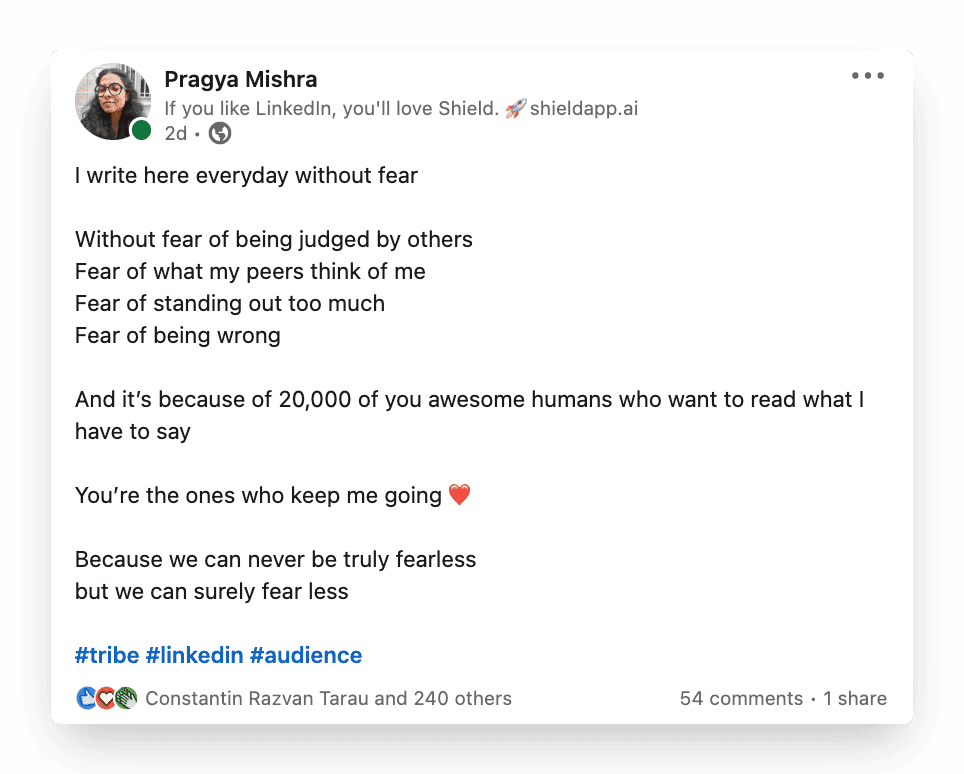
Idea #1: Introduce yourself
One of the best ways to introduce yourself to your growing network is, well, by introducing yourself!
It can be as simple as starting with your name, position and industry. Lead with a conversational tone of voice and be open about why you’re on LinkedIn, whether it’s to look for work or simply connect with others.
It’ll be easier for others to empathize with you if you take your corporate hat off and write straightforwardly. After all, there are two things people on LinkedIn hate: the ‘hard sell’ and essay-like posts that lose all readability after the first few lines.
Make your post short and snappy and think about who you’re writing for.
For example, if your aim is to create a conversation with others within your field, be sure to end with a call to action such as:
“If you work in the same industry drop an introduction👇”
Here’s a great example of an introductory LinkedIn post.
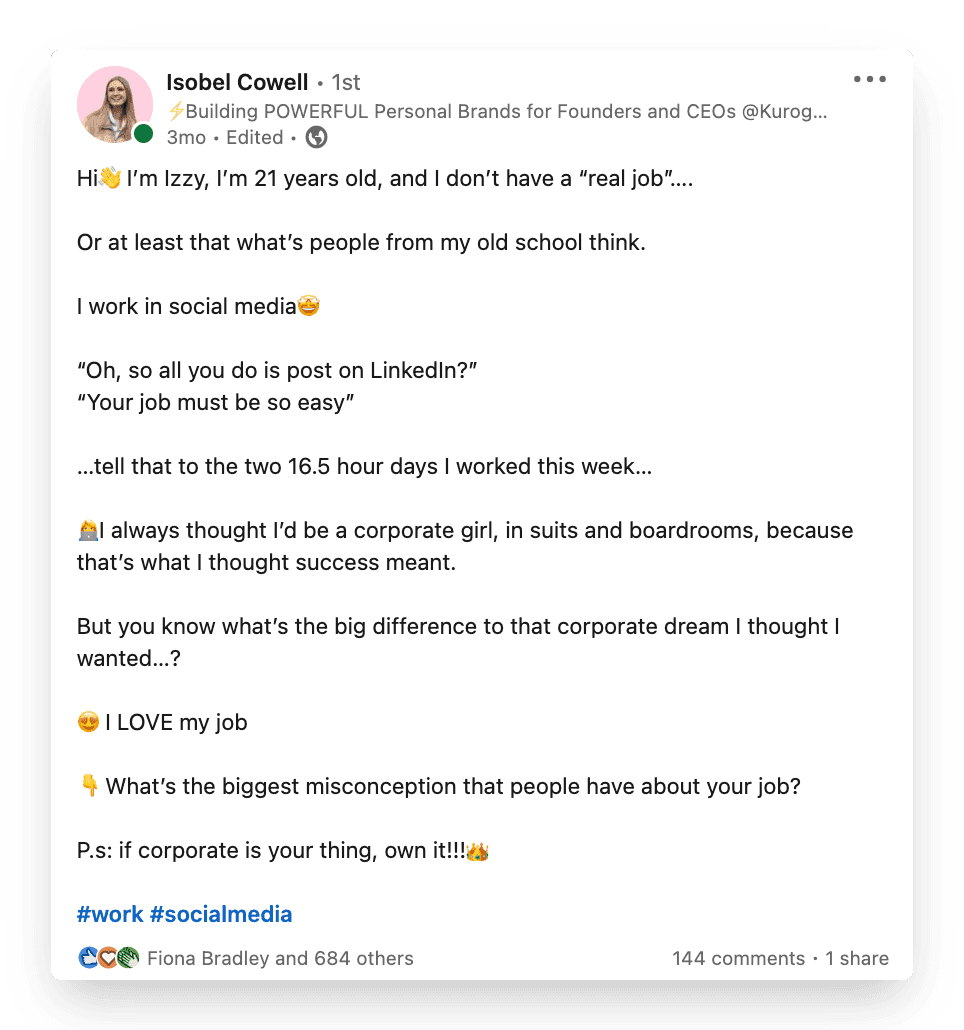
Idea #2: Draw attention to your first post
LinkedIn’s community, as a whole, is very supportive – especially to those looking to learn new things. So why not take advantage of this?
Highlighting your post as a first post on the platform, and acknowledging this, will motivate others to interact, either to wish you well or offer advice.
Of course, this strategy is particularly effective if you're Mr Beast.

If you want to use this strategy, start your post by addressing the audience and telling them this is your first post.
“Hi LinkedIn, I am new here…”
Bringing attention to your first post gives you the opportunity to talk about your reasons for starting your journey of building your personal brand. It also draws in others who are on a similar journey as you.
Idea #3: Ask a question 🙋♀️
There’s one foolproof way to start a conversation and promote engagement, and it’s simpler than you might think: ask a question
Even better, ask for advice. On a platform with everyone on the job spectrum – from Juniors Execs to CEOs – everyone is going to have unique experiences and life lessons that they’re willing to share.
The benefits to this – you’ll be introduced to a variety of new people and your network will grow as a result.
Plus, you’ll learn more about the subject you’re talking about.
Here’s a great example:
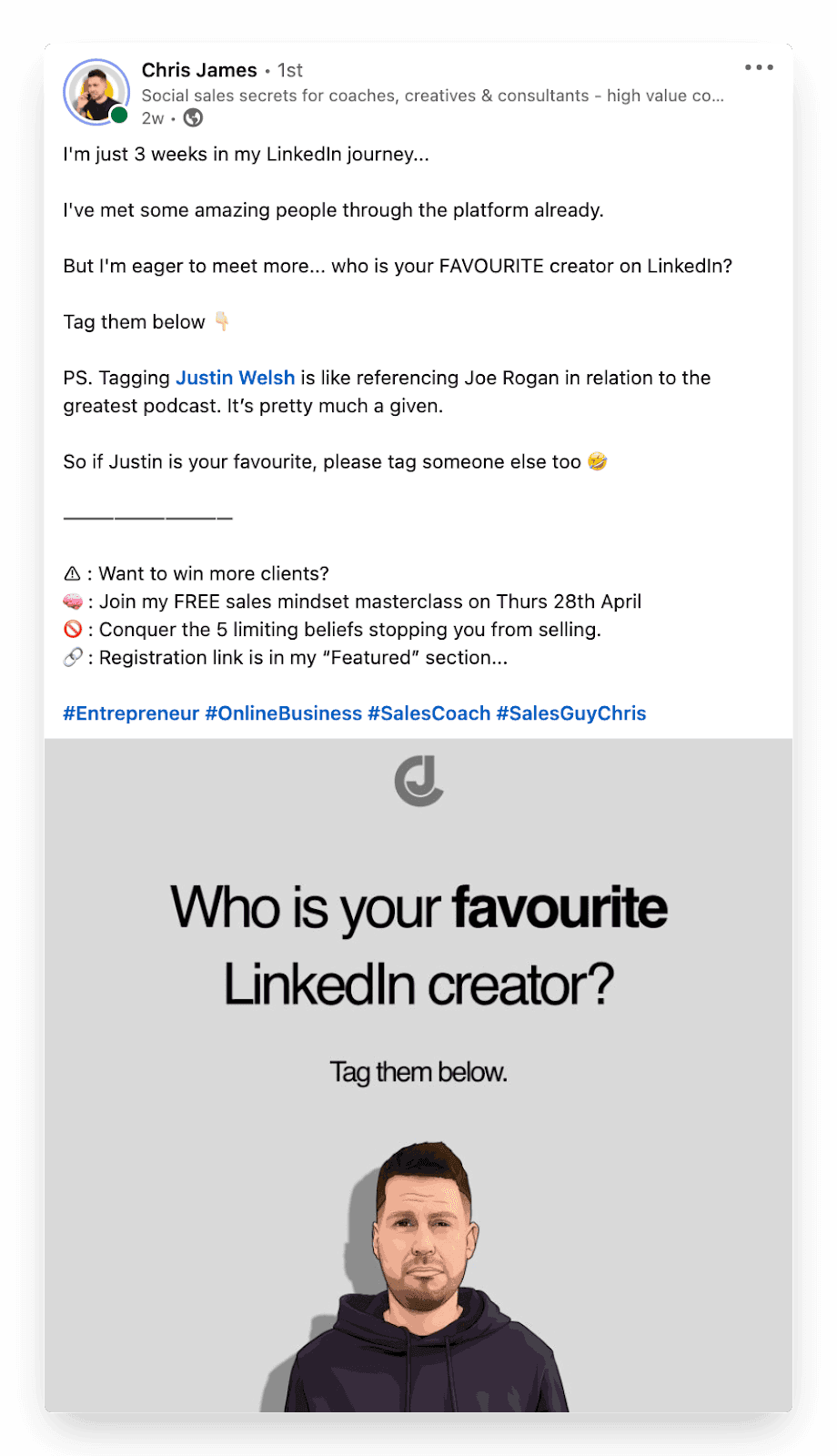
Idea #4: Document your experiences
The easiest way to remove self-doubt while creating content on LinkedIn is to document your own experiences instead of telling others "Do this, do that". Self-doubt comes into play when we try to preach what's right and wrong, what works and what doesn't. We at shield often say,
"Document, don't preach!"
Documenting is easy. We all have so many experiences in our everyday life. The story of what we did, how it worked, or why it failed can help so many other people. The most authentic way to establish authority is by documenting your own journey. This gives you the ability to say what you did and the learnings you had from that experience.
And yes, this even applies to everyone. If you are a student it could be school projects, if you are a job-seeker this could be interview attempts and application processes. If you just got started in your career it could be learnings you get from your colleagues – all provide good lessons that will benefit others.
Our top tip: Use ‘I’ language in your posts. For example, instead of writing: ‘Here are 5 common blog-writing mistakes’, write: ‘I published 10 blogs last month and these are my top 5 mistakes (that you can avoid)’.
When directing your post to your own experiences, you build credibility with your audience.
Take a look below for a great example of this in practice.
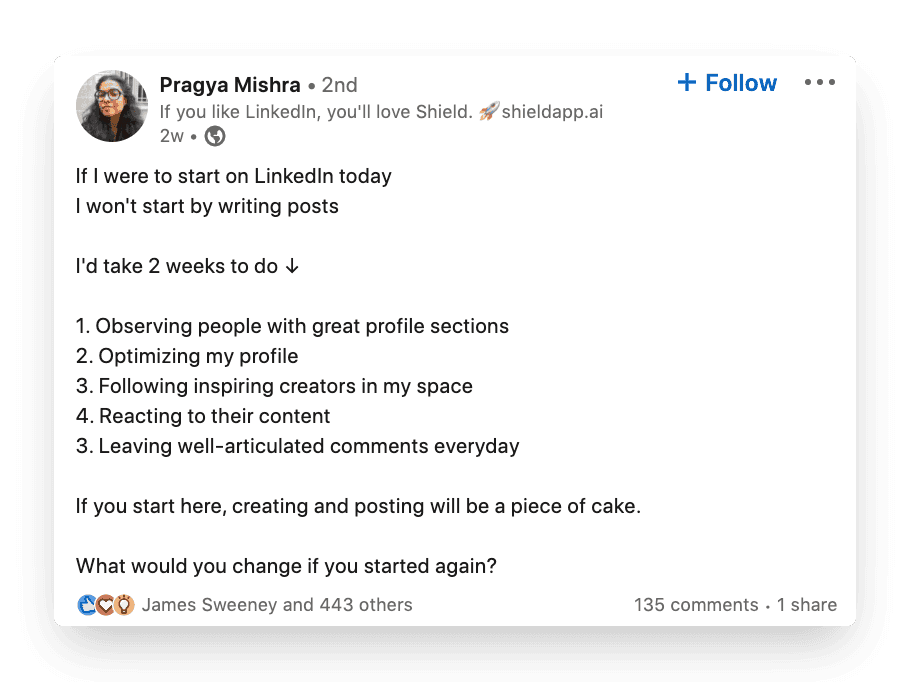
Idea #5: Challenge the status quo
LinkedIn is a "professional" social network. People are connected to their peers, their bosses, and their colleagues. Now this gives rise to a unique problem, group think. Everyone always agrees with each other. But that makes standing out easy with a contrary opinion or one that talks about the other side of the common narrative.
Take a look at posts that cover the main topics around your industry — what’s being said? Why? Now take what’s being said and consider how your experiences contradict them. The stronger the opinion (within reason), the stronger the chance of post interactions.
Here’s an example from Justin Welsh:
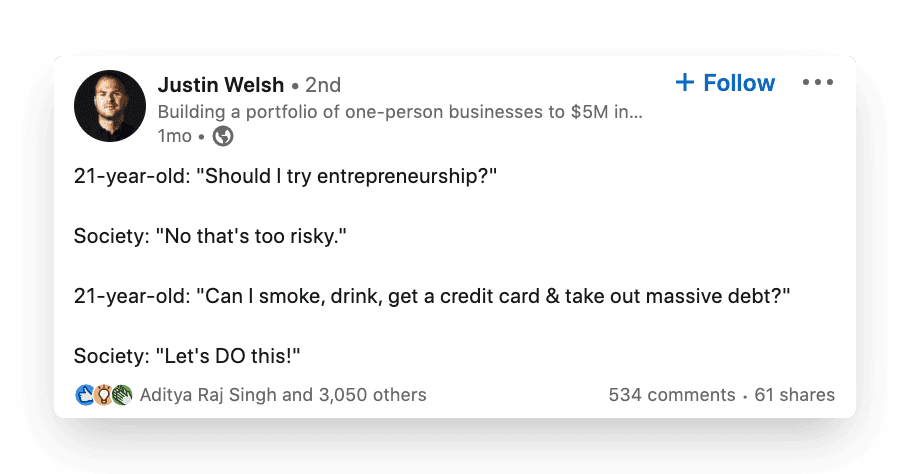
Here's another one from Andreas:
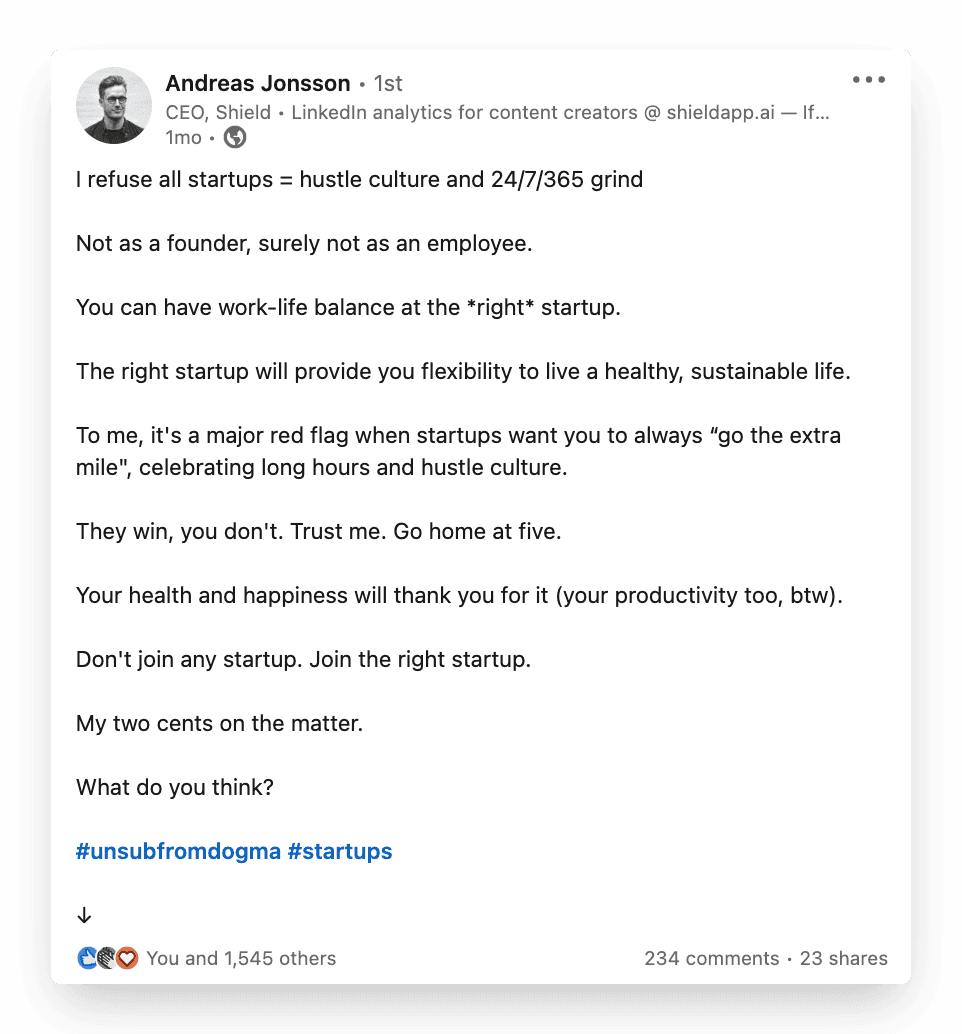
If you want to join the conversation on LinkedIn and start getting noticed, try these ideas and turn them into your own content. Hopefully, we’ve provided you with a few ideas to get you up and running. Here's a recap of 5 ideas on what to post on LinkedIn:
The introductory LinkedIn post
The self-referential ‘This is my first post’ post
The ‘Ask a question’ post
The ‘I tried X and here is what I learnt’ post
The ‘Unpopular Opinion’ post
With these in your toolkit, now there’s no excuse to not get started on LinkedIn. We look forward to seeing your posts! And tag us @Shield
Also, if you’re a few months in and starting to run thin on ideas, be sure to check out our other blog post on LinkedIn content ideas.
Until next time!
LinkedIn has approximately 810 million users. There are 2 million posts being published every day. If you want to join the creators who are actively publishing and telling their stories, it might be a bit daunting of a task to get started.
On a platform geared towards professionalism, one of the key blockers people face is imposter syndrome – not sure as to whether they’re qualified enough to speak on certain topics or where to start.
But, the benefits of creating content and building your personal branding are immense. Every creator we look up to and admire today for their content once started with doubts about their authority.
Building your presence on LinkedIn offers many benefits – it allows you to create a digital portfolio, build credibility and helps boost career prospects. In essence, if you want to propel your career or business in any specific direction, LinkedIn is the place to be.
The best way to overcome any growing pains on the platform is to just start writing, without fear and with plenty of personality. But to make it easier we will show you examples of posts that could be a great framework for you to be inspired by!
And the more you write the easier it gets!

Idea #1: Introduce yourself
One of the best ways to introduce yourself to your growing network is, well, by introducing yourself!
It can be as simple as starting with your name, position and industry. Lead with a conversational tone of voice and be open about why you’re on LinkedIn, whether it’s to look for work or simply connect with others.
It’ll be easier for others to empathize with you if you take your corporate hat off and write straightforwardly. After all, there are two things people on LinkedIn hate: the ‘hard sell’ and essay-like posts that lose all readability after the first few lines.
Make your post short and snappy and think about who you’re writing for.
For example, if your aim is to create a conversation with others within your field, be sure to end with a call to action such as:
“If you work in the same industry drop an introduction👇”
Here’s a great example of an introductory LinkedIn post.

Idea #2: Draw attention to your first post
LinkedIn’s community, as a whole, is very supportive – especially to those looking to learn new things. So why not take advantage of this?
Highlighting your post as a first post on the platform, and acknowledging this, will motivate others to interact, either to wish you well or offer advice.
Of course, this strategy is particularly effective if you're Mr Beast.

If you want to use this strategy, start your post by addressing the audience and telling them this is your first post.
“Hi LinkedIn, I am new here…”
Bringing attention to your first post gives you the opportunity to talk about your reasons for starting your journey of building your personal brand. It also draws in others who are on a similar journey as you.
Idea #3: Ask a question 🙋♀️
There’s one foolproof way to start a conversation and promote engagement, and it’s simpler than you might think: ask a question
Even better, ask for advice. On a platform with everyone on the job spectrum – from Juniors Execs to CEOs – everyone is going to have unique experiences and life lessons that they’re willing to share.
The benefits to this – you’ll be introduced to a variety of new people and your network will grow as a result.
Plus, you’ll learn more about the subject you’re talking about.
Here’s a great example:

Idea #4: Document your experiences
The easiest way to remove self-doubt while creating content on LinkedIn is to document your own experiences instead of telling others "Do this, do that". Self-doubt comes into play when we try to preach what's right and wrong, what works and what doesn't. We at shield often say,
"Document, don't preach!"
Documenting is easy. We all have so many experiences in our everyday life. The story of what we did, how it worked, or why it failed can help so many other people. The most authentic way to establish authority is by documenting your own journey. This gives you the ability to say what you did and the learnings you had from that experience.
And yes, this even applies to everyone. If you are a student it could be school projects, if you are a job-seeker this could be interview attempts and application processes. If you just got started in your career it could be learnings you get from your colleagues – all provide good lessons that will benefit others.
Our top tip: Use ‘I’ language in your posts. For example, instead of writing: ‘Here are 5 common blog-writing mistakes’, write: ‘I published 10 blogs last month and these are my top 5 mistakes (that you can avoid)’.
When directing your post to your own experiences, you build credibility with your audience.
Take a look below for a great example of this in practice.

Idea #5: Challenge the status quo
LinkedIn is a "professional" social network. People are connected to their peers, their bosses, and their colleagues. Now this gives rise to a unique problem, group think. Everyone always agrees with each other. But that makes standing out easy with a contrary opinion or one that talks about the other side of the common narrative.
Take a look at posts that cover the main topics around your industry — what’s being said? Why? Now take what’s being said and consider how your experiences contradict them. The stronger the opinion (within reason), the stronger the chance of post interactions.
Here’s an example from Justin Welsh:

Here's another one from Andreas:

If you want to join the conversation on LinkedIn and start getting noticed, try these ideas and turn them into your own content. Hopefully, we’ve provided you with a few ideas to get you up and running. Here's a recap of 5 ideas on what to post on LinkedIn:
The introductory LinkedIn post
The self-referential ‘This is my first post’ post
The ‘Ask a question’ post
The ‘I tried X and here is what I learnt’ post
The ‘Unpopular Opinion’ post
With these in your toolkit, now there’s no excuse to not get started on LinkedIn. We look forward to seeing your posts! And tag us @Shield
Also, if you’re a few months in and starting to run thin on ideas, be sure to check out our other blog post on LinkedIn content ideas.
Until next time!
LinkedIn has approximately 810 million users. There are 2 million posts being published every day. If you want to join the creators who are actively publishing and telling their stories, it might be a bit daunting of a task to get started.
On a platform geared towards professionalism, one of the key blockers people face is imposter syndrome – not sure as to whether they’re qualified enough to speak on certain topics or where to start.
But, the benefits of creating content and building your personal branding are immense. Every creator we look up to and admire today for their content once started with doubts about their authority.
Building your presence on LinkedIn offers many benefits – it allows you to create a digital portfolio, build credibility and helps boost career prospects. In essence, if you want to propel your career or business in any specific direction, LinkedIn is the place to be.
The best way to overcome any growing pains on the platform is to just start writing, without fear and with plenty of personality. But to make it easier we will show you examples of posts that could be a great framework for you to be inspired by!
And the more you write the easier it gets!

Idea #1: Introduce yourself
One of the best ways to introduce yourself to your growing network is, well, by introducing yourself!
It can be as simple as starting with your name, position and industry. Lead with a conversational tone of voice and be open about why you’re on LinkedIn, whether it’s to look for work or simply connect with others.
It’ll be easier for others to empathize with you if you take your corporate hat off and write straightforwardly. After all, there are two things people on LinkedIn hate: the ‘hard sell’ and essay-like posts that lose all readability after the first few lines.
Make your post short and snappy and think about who you’re writing for.
For example, if your aim is to create a conversation with others within your field, be sure to end with a call to action such as:
“If you work in the same industry drop an introduction👇”
Here’s a great example of an introductory LinkedIn post.

Idea #2: Draw attention to your first post
LinkedIn’s community, as a whole, is very supportive – especially to those looking to learn new things. So why not take advantage of this?
Highlighting your post as a first post on the platform, and acknowledging this, will motivate others to interact, either to wish you well or offer advice.
Of course, this strategy is particularly effective if you're Mr Beast.

If you want to use this strategy, start your post by addressing the audience and telling them this is your first post.
“Hi LinkedIn, I am new here…”
Bringing attention to your first post gives you the opportunity to talk about your reasons for starting your journey of building your personal brand. It also draws in others who are on a similar journey as you.
Idea #3: Ask a question 🙋♀️
There’s one foolproof way to start a conversation and promote engagement, and it’s simpler than you might think: ask a question
Even better, ask for advice. On a platform with everyone on the job spectrum – from Juniors Execs to CEOs – everyone is going to have unique experiences and life lessons that they’re willing to share.
The benefits to this – you’ll be introduced to a variety of new people and your network will grow as a result.
Plus, you’ll learn more about the subject you’re talking about.
Here’s a great example:

Idea #4: Document your experiences
The easiest way to remove self-doubt while creating content on LinkedIn is to document your own experiences instead of telling others "Do this, do that". Self-doubt comes into play when we try to preach what's right and wrong, what works and what doesn't. We at shield often say,
"Document, don't preach!"
Documenting is easy. We all have so many experiences in our everyday life. The story of what we did, how it worked, or why it failed can help so many other people. The most authentic way to establish authority is by documenting your own journey. This gives you the ability to say what you did and the learnings you had from that experience.
And yes, this even applies to everyone. If you are a student it could be school projects, if you are a job-seeker this could be interview attempts and application processes. If you just got started in your career it could be learnings you get from your colleagues – all provide good lessons that will benefit others.
Our top tip: Use ‘I’ language in your posts. For example, instead of writing: ‘Here are 5 common blog-writing mistakes’, write: ‘I published 10 blogs last month and these are my top 5 mistakes (that you can avoid)’.
When directing your post to your own experiences, you build credibility with your audience.
Take a look below for a great example of this in practice.

Idea #5: Challenge the status quo
LinkedIn is a "professional" social network. People are connected to their peers, their bosses, and their colleagues. Now this gives rise to a unique problem, group think. Everyone always agrees with each other. But that makes standing out easy with a contrary opinion or one that talks about the other side of the common narrative.
Take a look at posts that cover the main topics around your industry — what’s being said? Why? Now take what’s being said and consider how your experiences contradict them. The stronger the opinion (within reason), the stronger the chance of post interactions.
Here’s an example from Justin Welsh:

Here's another one from Andreas:

If you want to join the conversation on LinkedIn and start getting noticed, try these ideas and turn them into your own content. Hopefully, we’ve provided you with a few ideas to get you up and running. Here's a recap of 5 ideas on what to post on LinkedIn:
The introductory LinkedIn post
The self-referential ‘This is my first post’ post
The ‘Ask a question’ post
The ‘I tried X and here is what I learnt’ post
The ‘Unpopular Opinion’ post
With these in your toolkit, now there’s no excuse to not get started on LinkedIn. We look forward to seeing your posts! And tag us @Shield
Also, if you’re a few months in and starting to run thin on ideas, be sure to check out our other blog post on LinkedIn content ideas.
Until next time!
LinkedIn has approximately 810 million users. There are 2 million posts being published every day. If you want to join the creators who are actively publishing and telling their stories, it might be a bit daunting of a task to get started.
On a platform geared towards professionalism, one of the key blockers people face is imposter syndrome – not sure as to whether they’re qualified enough to speak on certain topics or where to start.
But, the benefits of creating content and building your personal branding are immense. Every creator we look up to and admire today for their content once started with doubts about their authority.
Building your presence on LinkedIn offers many benefits – it allows you to create a digital portfolio, build credibility and helps boost career prospects. In essence, if you want to propel your career or business in any specific direction, LinkedIn is the place to be.
The best way to overcome any growing pains on the platform is to just start writing, without fear and with plenty of personality. But to make it easier we will show you examples of posts that could be a great framework for you to be inspired by!
And the more you write the easier it gets!

Idea #1: Introduce yourself
One of the best ways to introduce yourself to your growing network is, well, by introducing yourself!
It can be as simple as starting with your name, position and industry. Lead with a conversational tone of voice and be open about why you’re on LinkedIn, whether it’s to look for work or simply connect with others.
It’ll be easier for others to empathize with you if you take your corporate hat off and write straightforwardly. After all, there are two things people on LinkedIn hate: the ‘hard sell’ and essay-like posts that lose all readability after the first few lines.
Make your post short and snappy and think about who you’re writing for.
For example, if your aim is to create a conversation with others within your field, be sure to end with a call to action such as:
“If you work in the same industry drop an introduction👇”
Here’s a great example of an introductory LinkedIn post.

Idea #2: Draw attention to your first post
LinkedIn’s community, as a whole, is very supportive – especially to those looking to learn new things. So why not take advantage of this?
Highlighting your post as a first post on the platform, and acknowledging this, will motivate others to interact, either to wish you well or offer advice.
Of course, this strategy is particularly effective if you're Mr Beast.

If you want to use this strategy, start your post by addressing the audience and telling them this is your first post.
“Hi LinkedIn, I am new here…”
Bringing attention to your first post gives you the opportunity to talk about your reasons for starting your journey of building your personal brand. It also draws in others who are on a similar journey as you.
Idea #3: Ask a question 🙋♀️
There’s one foolproof way to start a conversation and promote engagement, and it’s simpler than you might think: ask a question
Even better, ask for advice. On a platform with everyone on the job spectrum – from Juniors Execs to CEOs – everyone is going to have unique experiences and life lessons that they’re willing to share.
The benefits to this – you’ll be introduced to a variety of new people and your network will grow as a result.
Plus, you’ll learn more about the subject you’re talking about.
Here’s a great example:

Idea #4: Document your experiences
The easiest way to remove self-doubt while creating content on LinkedIn is to document your own experiences instead of telling others "Do this, do that". Self-doubt comes into play when we try to preach what's right and wrong, what works and what doesn't. We at shield often say,
"Document, don't preach!"
Documenting is easy. We all have so many experiences in our everyday life. The story of what we did, how it worked, or why it failed can help so many other people. The most authentic way to establish authority is by documenting your own journey. This gives you the ability to say what you did and the learnings you had from that experience.
And yes, this even applies to everyone. If you are a student it could be school projects, if you are a job-seeker this could be interview attempts and application processes. If you just got started in your career it could be learnings you get from your colleagues – all provide good lessons that will benefit others.
Our top tip: Use ‘I’ language in your posts. For example, instead of writing: ‘Here are 5 common blog-writing mistakes’, write: ‘I published 10 blogs last month and these are my top 5 mistakes (that you can avoid)’.
When directing your post to your own experiences, you build credibility with your audience.
Take a look below for a great example of this in practice.

Idea #5: Challenge the status quo
LinkedIn is a "professional" social network. People are connected to their peers, their bosses, and their colleagues. Now this gives rise to a unique problem, group think. Everyone always agrees with each other. But that makes standing out easy with a contrary opinion or one that talks about the other side of the common narrative.
Take a look at posts that cover the main topics around your industry — what’s being said? Why? Now take what’s being said and consider how your experiences contradict them. The stronger the opinion (within reason), the stronger the chance of post interactions.
Here’s an example from Justin Welsh:

Here's another one from Andreas:

If you want to join the conversation on LinkedIn and start getting noticed, try these ideas and turn them into your own content. Hopefully, we’ve provided you with a few ideas to get you up and running. Here's a recap of 5 ideas on what to post on LinkedIn:
The introductory LinkedIn post
The self-referential ‘This is my first post’ post
The ‘Ask a question’ post
The ‘I tried X and here is what I learnt’ post
The ‘Unpopular Opinion’ post
With these in your toolkit, now there’s no excuse to not get started on LinkedIn. We look forward to seeing your posts! And tag us @Shield
Also, if you’re a few months in and starting to run thin on ideas, be sure to check out our other blog post on LinkedIn content ideas.
Until next time!


